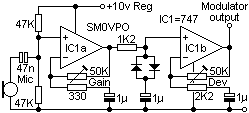One of this day I was thinking (I do that sometimes) that could be nice to add some FM capability (RX/TX) for the Bitx or, for that mater, to any other similar design. For the RX part, there are plenty of FM demodulator IC's and even some old school designs using IF coils, but keeping the tradition of doing more with less or at least with more available parts around the world, here's one of my tests.
Transmitter part:
Audio modulator (I used 2 741):
 Implementation (I added one mic amp):
Implementation (I added one mic amp):
The design is by SM0VPO except the mic preamp that is a common preamp circuit
Now for the FM modulation, a super VXO at 10Mhz, bellow:
 I used a previous pcb board from the AM light modulator for the buffer power vxo supply (AM for the bitx? Maybe next!). Hard to get parts? probably the BB105 varicap diode but I'm doing some tests with high power zeners (1 and 5W) that probably can be used.
I used a previous pcb board from the AM light modulator for the buffer power vxo supply (AM for the bitx? Maybe next!). Hard to get parts? probably the BB105 varicap diode but I'm doing some tests with high power zeners (1 and 5W) that probably can be used.Receiving:
The demodulation part:
 The schematic in the receiving part, was an adaptation from a "Russian" schematic I found somewhere, so components values were more or less my interpretation.
The schematic in the receiving part, was an adaptation from a "Russian" schematic I found somewhere, so components values were more or less my interpretation. The amp before is the same of the one after the crystal filter in the Bitx design..
The amp before is the same of the one after the crystal filter in the Bitx design..Honestly schematic looks like a phase demodulator but I still didn't fully understand it, looks more a full wave AM demodulator than an FM one. Fact is, it works to some extend.
The reception part is to be fitted after the crystal filter in the Bitx, of course a new wider filter design have to be used due to FM bandwidth.
The above schematic do works but will need more amplification (another IF amp probably) or at least more impedance match in the reception part, so it's not in for "production level" and I will not put here full schematic. Consider this a starting place for some experimenting.
If you have any simple design for FM demodulation at 10Mhz I would like to know.
Anyhow FM only makes sense for a 10m version of the Bitx or for transverter use.
Have fun!













